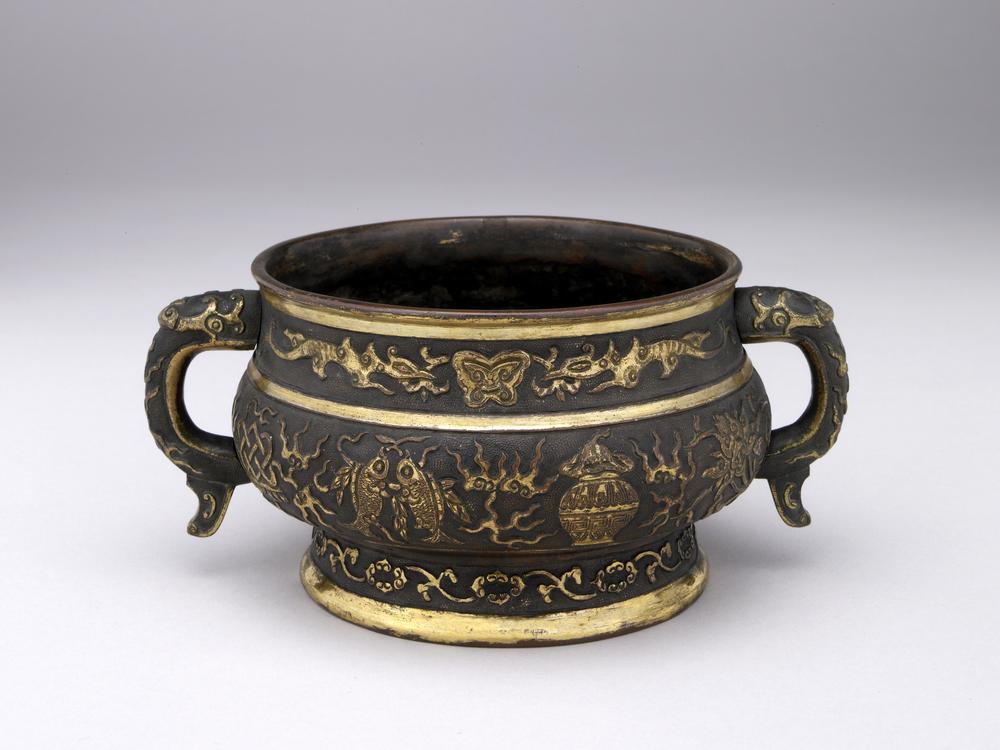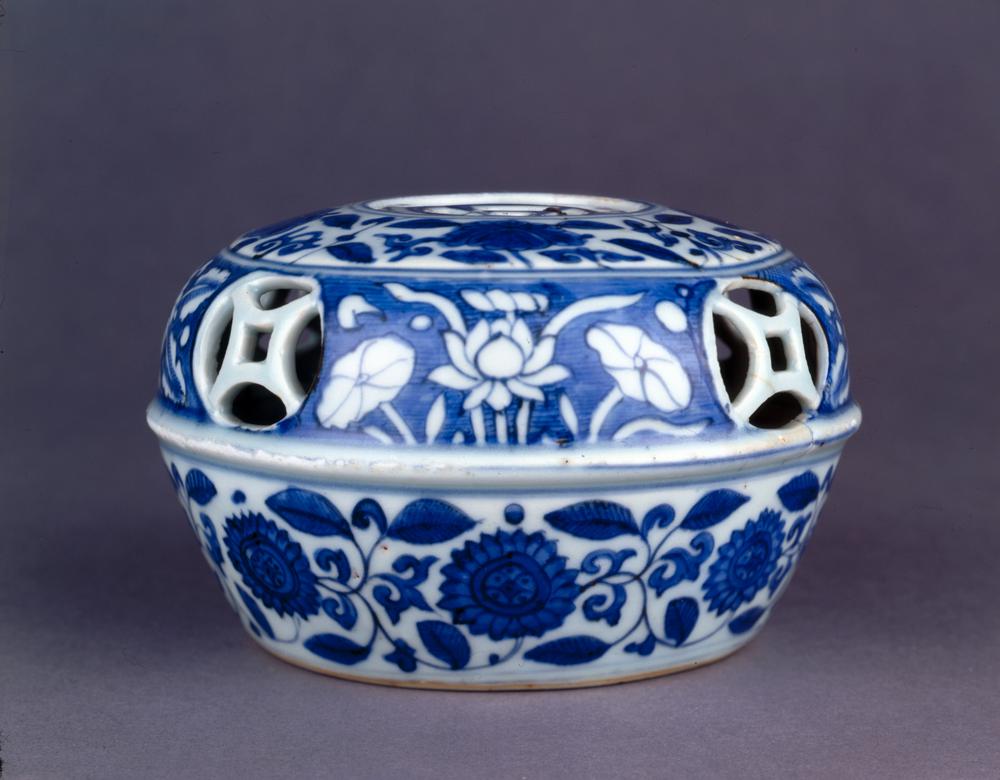Period:Southern Song dynasty Production date:13thC
Materials:silk
Technique:painted
Subjects:equestrian falconry/hawking bird asian
Dimensions:Height: 24.80 centimetres Width: 26.30 centimetres
Description:
Chinese painting in album leaf format in ink and colour on silk. Depiction of a horse caparisoned with a tiger skin and empty saddle standing next to the rider, a bearded falconer wearing a tight, belted robe and skull cap, with his horse whip neatly tucked behind his back. The rider’s right forearm is extended as a perch for a large peregrine falcon and rider and bird are engaged in an intense mutual gaze. A few delicate tufts of grass are painted beneath the feet of the falconer and steed, but otherwise the background is void, with the exception of a signature (probably spurious) and six collectors’ seals.
IMG
![图片[1]-painting BM-2010-3031.1-China Archive](https://chinaarchive.net/Southern Song dynasty/Paintings/mid_00958892_001.jpg)
![图片[2]-painting BM-2010-3031.1-China Archive](https://chinaarchive.net/Southern Song dynasty/Paintings/mid_01510305_001.jpg)
Comments:(notes by Jan Stuart, December 2010)This work bears a signature line with the name of Chen Juzhong (act. ca. 1201-30), but this is probably a later interpolation. Although the actual artist’s name is unknown, the work is certainly of Southern Song date, in the 13th century. Chen was known for works of a similar theme and his name is widely assigned to horse paintings of this type (and so great was his fame that his name has sometimes also been appropriated for all manner of horse paintings, including a late work in the BM’s collection assigned by tradition to Chen Juzhong but which has nothing to do with Chen’s original works). The subject of this painting is a majestic horse and falconer who stands near the steed with forearm extended as a perch for his large bird of prey (probably the heavier female falcon). Caparisoned with a tiger skin and empty saddle, the horse attentively watches the rider and his bird whom together form a tightly bonded unit engaged in intense eye contact. The falconer’s penetrating gaze fixes the eye of the great bird, seemingly communicating some secret message or command. The moustached and bearded rider, whose horsewhip is neatly tucked behind his waist, wears a tight cap, long green tunic, red under-robe and trousers. His costume and facial features identify him as from Central Asia. He could represent a Khitan (Qidan) hunter or perhaps a Jurchen, people adept at hunting with falcons and whose histories were closely interwoven with China’s. Further evidence of Central Asian connection is apparent in the steed, a foreign breed whose ears have been clipped and dressed in a fashion popular in Central Asia. The painting probably depicts the hunting customs of the nomadic Khitan (Qidan), who during their brief rule of China (and parts of Manchuria and Mongolia) introduced hunting with falcons to China. While the period of Khitan rule, which was known as the Liao dynasty (915—1125), significantly predates the execution of this painting in the thirteenth century, the subject matter hasd long popularity in China and had its own powerful resonance in the Chinese-ruled Southern Song dynasty of the thirteenth century, when the Chinese court stayed alert to the presence and threat of the then-in-place Jurchen rulers of north China, whose culture had subsumed elements of Khitan life. A datable seal on the painting belonging to a Ming dynasty imperial prince (Zhu Gang, Prince of Jin) attests to the continued enthusiasm and interest in later periods for the theme of Khitan hunters, especially when such a topic was available in a high-quality, Song dynasty painting as Ming collectors were particularly admiring of Song artists’ styles. The likely subject of this painting is the annual spring hunting exercise by the Khitans, when attendants were recorded to have worn green robes. The Liao emperor released eagles and falcons every spring to catch swans and wild geese for the court and his attendants wore green (see references by Karl Wittogel and Feng Chia-sheng, History of Chinese Society: Liao 907-1125), The American Philosophical Society, Philideliphia, 1949, p. 132). Since the early Tang dynasty, the theme of painting horses and grooms or hunters from Central Asia took a special place in the corpus of Chinese paintings. Chinese interest in their northern neighbours was always keen—sometimes seen from the perspective of Chinese strength as when Central Asian people brought tribute horses and sometimes witnessed from the vantage of the strength of foreigners, such as when the Khitan and Jurchen peoples temporarily ruled parts of China. This particular painting bears close comparison to a work of similar size and style in the Boston Museum of Fine Arts that has traditionally been attributed to Hu Gui (first half of the 10th century) and which depicts a Khitan hunter. The Boston painting has recently been determined to be an anonymous work of the Southern Song dynasty in the 12th century according to the work of Wu Tung. It would be an earlier prototype of the interest in the type of theme seen here and provides some contextual understanding for the style and popularity of this type of work in the Southern Song .Set against a void background, the artist subtly suggested the ground plane by depicting a few delicate tufts of grass near the feet of man and beast. The use of open space is, however, a typical device in Southern Song Chinese paintings, and one of several features that helps place this work in the Song. The open space is especially effective here as a suggestion of the open sweep of the Central Asian steppes. According to Roderick Whitfield (in Eskenazi: Seven Classical Chinese Paintings, London, 2009, p. 10), …”Consciously or not, therefore, the subject of a non-Chinese groom leading a fine horse refers to the vast extent of the Chinese empire and its tributary relationships, as well as the equestrian and hunting life of China’s northern neighbours.”
Materials:silk
Technique:painted
Subjects:equestrian falconry/hawking bird asian
Dimensions:Height: 24.80 centimetres Width: 26.30 centimetres
Description:
Chinese painting in album leaf format in ink and colour on silk. Depiction of a horse caparisoned with a tiger skin and empty saddle standing next to the rider, a bearded falconer wearing a tight, belted robe and skull cap, with his horse whip neatly tucked behind his back. The rider’s right forearm is extended as a perch for a large peregrine falcon and rider and bird are engaged in an intense mutual gaze. A few delicate tufts of grass are painted beneath the feet of the falconer and steed, but otherwise the background is void, with the exception of a signature (probably spurious) and six collectors’ seals.
IMG
![图片[1]-painting BM-2010-3031.1-China Archive](https://chinaarchive.net/Southern Song dynasty/Paintings/mid_00958892_001.jpg)
![图片[2]-painting BM-2010-3031.1-China Archive](https://chinaarchive.net/Southern Song dynasty/Paintings/mid_01510305_001.jpg)
Comments:(notes by Jan Stuart, December 2010)This work bears a signature line with the name of Chen Juzhong (act. ca. 1201-30), but this is probably a later interpolation. Although the actual artist’s name is unknown, the work is certainly of Southern Song date, in the 13th century. Chen was known for works of a similar theme and his name is widely assigned to horse paintings of this type (and so great was his fame that his name has sometimes also been appropriated for all manner of horse paintings, including a late work in the BM’s collection assigned by tradition to Chen Juzhong but which has nothing to do with Chen’s original works). The subject of this painting is a majestic horse and falconer who stands near the steed with forearm extended as a perch for his large bird of prey (probably the heavier female falcon). Caparisoned with a tiger skin and empty saddle, the horse attentively watches the rider and his bird whom together form a tightly bonded unit engaged in intense eye contact. The falconer’s penetrating gaze fixes the eye of the great bird, seemingly communicating some secret message or command. The moustached and bearded rider, whose horsewhip is neatly tucked behind his waist, wears a tight cap, long green tunic, red under-robe and trousers. His costume and facial features identify him as from Central Asia. He could represent a Khitan (Qidan) hunter or perhaps a Jurchen, people adept at hunting with falcons and whose histories were closely interwoven with China’s. Further evidence of Central Asian connection is apparent in the steed, a foreign breed whose ears have been clipped and dressed in a fashion popular in Central Asia. The painting probably depicts the hunting customs of the nomadic Khitan (Qidan), who during their brief rule of China (and parts of Manchuria and Mongolia) introduced hunting with falcons to China. While the period of Khitan rule, which was known as the Liao dynasty (915—1125), significantly predates the execution of this painting in the thirteenth century, the subject matter hasd long popularity in China and had its own powerful resonance in the Chinese-ruled Southern Song dynasty of the thirteenth century, when the Chinese court stayed alert to the presence and threat of the then-in-place Jurchen rulers of north China, whose culture had subsumed elements of Khitan life. A datable seal on the painting belonging to a Ming dynasty imperial prince (Zhu Gang, Prince of Jin) attests to the continued enthusiasm and interest in later periods for the theme of Khitan hunters, especially when such a topic was available in a high-quality, Song dynasty painting as Ming collectors were particularly admiring of Song artists’ styles. The likely subject of this painting is the annual spring hunting exercise by the Khitans, when attendants were recorded to have worn green robes. The Liao emperor released eagles and falcons every spring to catch swans and wild geese for the court and his attendants wore green (see references by Karl Wittogel and Feng Chia-sheng, History of Chinese Society: Liao 907-1125), The American Philosophical Society, Philideliphia, 1949, p. 132). Since the early Tang dynasty, the theme of painting horses and grooms or hunters from Central Asia took a special place in the corpus of Chinese paintings. Chinese interest in their northern neighbours was always keen—sometimes seen from the perspective of Chinese strength as when Central Asian people brought tribute horses and sometimes witnessed from the vantage of the strength of foreigners, such as when the Khitan and Jurchen peoples temporarily ruled parts of China. This particular painting bears close comparison to a work of similar size and style in the Boston Museum of Fine Arts that has traditionally been attributed to Hu Gui (first half of the 10th century) and which depicts a Khitan hunter. The Boston painting has recently been determined to be an anonymous work of the Southern Song dynasty in the 12th century according to the work of Wu Tung. It would be an earlier prototype of the interest in the type of theme seen here and provides some contextual understanding for the style and popularity of this type of work in the Southern Song .Set against a void background, the artist subtly suggested the ground plane by depicting a few delicate tufts of grass near the feet of man and beast. The use of open space is, however, a typical device in Southern Song Chinese paintings, and one of several features that helps place this work in the Song. The open space is especially effective here as a suggestion of the open sweep of the Central Asian steppes. According to Roderick Whitfield (in Eskenazi: Seven Classical Chinese Paintings, London, 2009, p. 10), …”Consciously or not, therefore, the subject of a non-Chinese groom leading a fine horse refers to the vast extent of the Chinese empire and its tributary relationships, as well as the equestrian and hunting life of China’s northern neighbours.”
© Copyright
The copyright of the article belongs to the author, please keep the original link for reprinting.
THE END
![[Qing Dynasty] British female painter—Elizabeth Keith, using woodblock prints to record China from the late Qing Dynasty to the early Republic of China—1915-China Archive](https://chinaarchive.net/wp-content/uploads/2022/11/image-191x300.png)




